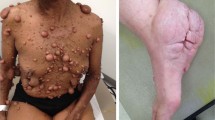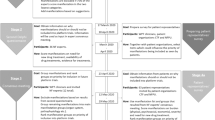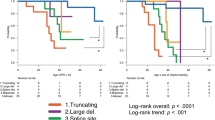Abstract
Neurofibromatosis type 1 (NF1) is a hereditary disease caused by mutations of the NF1 gene at 17q11.2. Loss of the NF1 gene product in Schwann cells leads to the development of benign nerve sheath tumors. These neurofibromas may occur at any time but tend to arise during periods of hormonal imbalance, suggesting that hormones influence neurofibroma growth. As steroid hormone levels rise during these times, we hypothesized that progesterone has proliferative effects on neurofibroma-derived Schwann cells. We chose specific medium conditions for selective proliferation of NF (+/−) and NF (−/−) cells from human neurofibromas. Genetic characterization was not performed, but former works have shown that under the conditions used (+/−) and (−/−) cells can be selected. Different progesterone concentrations were added at different days with BrdU-staining was performed to investigate proliferation rates and DAB-staining to identify a progesterone receptor. We could demonstrate that Schwann cells from human neurofibromas express progesterone receptors. These cells show elevated proliferation rates (highest in NF(−/−) cells) under progesterone, whereas normal human Schwann cells were not affected. These data suggest that progesterone plays an important role in the development of neurofibromas in NF1.
Similar content being viewed by others
Log in or create a free account to read this content
Gain free access to this article, as well as selected content from this journal and more on nature.com
or
Abbreviations
- NF1:
-
neurofibromatosis type 1
References
Friedman JM, Riccardi VM 1992 Clinical and epidemiologic features in NF1. Friedman JM, Gutman DH, McCollin M, Riccardi VM Neurofibromatosis. Phenotype, Natural History and Pathogenesis, 2nd ed. The Johns Hopkins University Press, Baltimore 29–86
Mulvihill JJ, Parry DM, Sherman JL, Pikus A, Kaiser-Kupfer ML, Eldridge R 1990 NIH conference: neurofibromatosis 1 (Recklinghausen disease) and neurofibromatosis 2 (bilateral acoustic neurofibromatosis). An Update. Ann Intern Med 113: 39–52
Peltonen J, Jaakkola S, Lebwohl M, Renvall S, Risteli L, Virtanen I, Uitto J 1988 Cellular differentiation and expression of matrix genes in type 1 neurofibromatosis. Lab Invest 59: 760–771
Serra E, Rosenbaum T, Winner U, Aledo R, Ars E, Estivill X, Lenard HG, Lázaro C 2000 Schwann cells harbor the somatic NF1 mutation in neurofibromas: evidence of two different schwann cell subpopulations. Hum Mol Genet 9: 3055–3064
Kluwe L, Friedrich R, Mautner VF 1999 Loss of NF1 allele in schwann cells but not in fibroblasts derived from an NF1-associated neurofibroma. Genes Chromosomes Cancer 24: 283–285
Cichowski K, Tyler J 2001 NF1 tumor suppressor gene function: narrowing the GAP. Cell 104: 593–604
Zhu Y, Ghosh P, Charnay P, Burns DK, Parada LF 2002 Neurofibromas in NF1: schwann cell origin and role of tumor environment. Science 296: 920–922
Jung-Testas I, Schumacher M, Robel P, Baulieu E 1996 Demonstration of progesterone receptors in rat schwann cells. J Steroid Biochem Mol Biol 58: 77–82
McLaughlin ME, Jacks T 2003 Progesterone receptor expression in neurofibromas. Cancer Res 63: 752–755
Fishbein L, Zhang X, Fisher LB, Li H, Campbell-Thompson M, Yachnis A, Rubenstein A, Muir D, Wallace MR 2007 In vitro studies of steroid hormones in neurofibromatosis 1 tumors and schwann cells. Mol Carcinog 46: 512–523
Rosenbaum T, Rosenbaum C, Winner U, Müller HW, Lenard HG, Hanemann CO 2000 Long-term culture and characterization of human neurofibroma-derived schwann cells. J Neurosci Res 61: 524–532
Maertens O, Prenen H, Debiec-Rychter M, Wozniak A, Sciot R, Pauwels P, de Wever I, Vermeesch JR, de Raedt T, de Paepe A, Speleman F, van Oosterom A, Messiaen L, Legius E 2006 Molecular pathogenesis of multiple gastrointestinal stromal tumors in NF1 patients. Hum Mol Genet 15: 1015–1023
Rutkowski JL, Kirk CJ, Lerner MA, Tennekoon GI 1995 Purification and expansion of human Schwann cells in vitro. Nat Med 1: 80–83
Hanemann CO, Rosenbaum C, Kupfer S, Wosch S, Stoegbauer F, Muller HW 1998 Improved culture methods to expand schwann cells with altered growth behaviour from CMT1A patients. Glia 23: 89–98
Rosenbaum C, Kluwe L, Mautner VF, Friedrich RE, Muller HW, Hanemann CO 1998 Isolation and characterization of schwann cells from neurofibromatosis type 2 patients. Neurobiol Dis 5: 55–64
Bosse F, Zoidl G, Wilms S, Gillen CP, Kuhn HG, Muller HW 1994 Differential expression of two mRNA species indicates a dual function of peripheral myelin protein PMP22 in cell growth and myelination. J Neurosci Res 37: 529–537
Bottenstein JE, Sato GH 1979 Growth of a neuroblastoma cell line in serum-free supplemented medium. Proc Natl Acad Sci USA 76: 514–517
Bartolami S, Auge C, Travo C, Venteo S, Knipper M, Sans A 2003 Vestibular schwann cells are a distinct subpopulation of peripheral glia with specific sensitivity to growth factors and extracellular matrix components. J Neurobiol 57: 270–290
Mashour GA, Driever PH, Hartmann M, Drissel SN, Zhang T, Scharf B, Felderhoff-Muser U, Sakuma S, Friedrich RE, Martuza RL, Mautner VF, Kurtz A 2004 Circulating growth factor levels are associated with tumorigenesis in neurofibromatosis type 1. Clin Cancer Res 10: 5677–5683
Robert F, Guennoun R, Désarnaud F, Do-Thi A, Benmessahel Y, Baulieu EE, Schumacher M 2001 Synthesis of progesterone in schwann cells: regulation by sensory neurons. Eur J Neurosci 13: 916–924
Kim HA, Rosenbaum T, Marchionni M, Ratner N, DeClue JE 1995 Schwann cells from neurofibromin deficient mice exhibit activation of p21ras, inhibition of cell proliferation and morphological changes. Oncogene 11: 325–335
Lammert M, Mautner VF, Kluwe L 2005 Do hormonal contraceptives stimulate growth of neurofibromas? A survey on 59 NF1 patients. BMC Cancer 5: 16
Acknowledgements
We thank Dr. Conxi Lázaro and Dr. Eduard Serra, Medical and Molecular Genetics Center-IRO, Hospital Duran i Reynals, L'Hospitalet de Llobregat, Barcelona/Spain for continuous intellectual and molecular genetic support as well as critical reading and comments on the manuscript. We thank Murray Hartley, Great Britain, for proof reading our manuscript.
Author information
Authors and Affiliations
Corresponding author
Additional information
This work was supported by Deutsche Krebshilfe (grant no. 50–2713).
Rights and permissions
About this article
Cite this article
Overdiek, A., Winner, U., Mayatepek, E. et al. Schwann Cells From Human Neurofibromas Show Increased Proliferation Rates Under the Influence of Progesterone. Pediatr Res 64, 40–43 (2008). https://doi.org/10.1203/PDR.0b013e31817445b8
Received:
Accepted:
Issue date:
DOI: https://doi.org/10.1203/PDR.0b013e31817445b8
This article is cited by
-
Cutaneous neurofibromas in the genomics era: current understanding and open questions
British Journal of Cancer (2018)
-
Receptor of ghrelin is expressed in cutaneous neurofibromas of individuals with neurofibromatosis 1
Orphanet Journal of Rare Diseases (2017)
-
Treatment of Neurofibromatosis Type 1
Current Treatment Options in Neurology (2015)
-
Clinical characteristics predicting internal neurofibromas in 357 children with neurofibromatosis-1: results from a cross-selectional study
Orphanet Journal of Rare Diseases (2012)
-
Genotype-phenotype associations in neurofibromatosis type 1 (NF1): an increased risk of tumor complications in patients with NF1splice-site mutations?
Human Genomics (2012)



